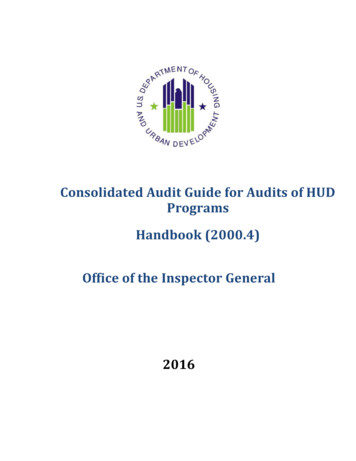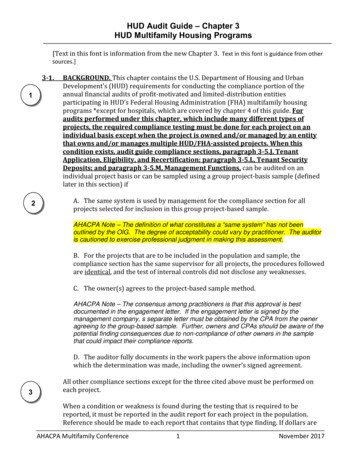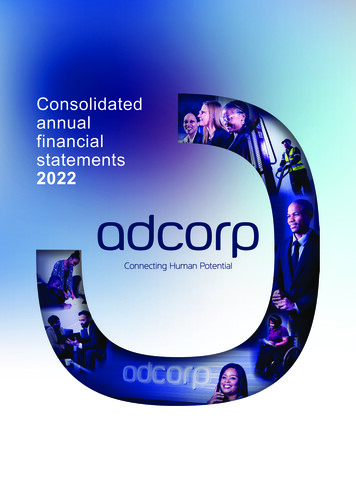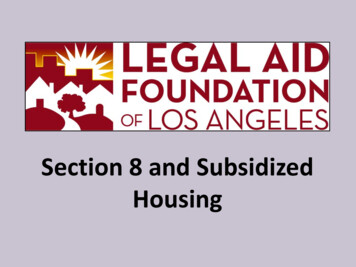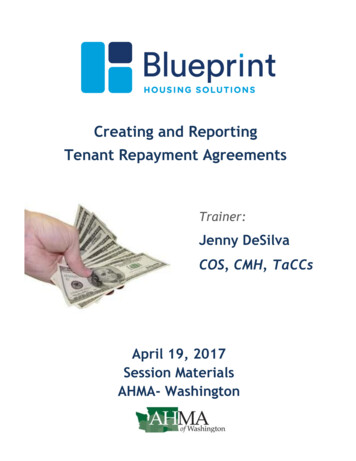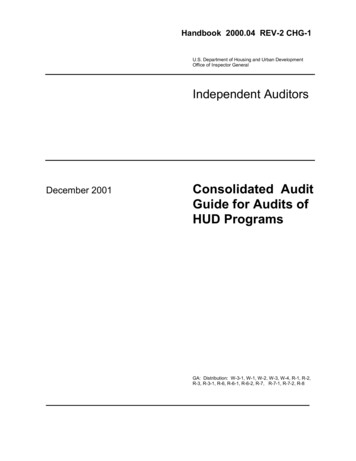
Transcription
Handbook 2000.04 REV-2 CHG-1U.S. Department of Housing and Urban DevelopmentOffice of Inspector GeneralIndependent AuditorsDecember 2001Consolidated AuditGuide for Audits ofHUD ProgramsGA: Distribution: W-3-1, W-1, W-2, W-3, W-4, R-1, R-2,R-3, R-3-1, R-6, R-6-1, R-6-2, R-7, R-7-1, R-7-2, R-8
U.S. Department of Housing and Urban DevelopmentOffice of the Inspector GeneralSPECIAL ATTENTION OF:Title II and I Mortgagees, Lenders,Loan Correspondents, Loan ManagementBranch Chiefs, Ginnie Mae Issuers,Owners, Management AgentsTRANSMITTALHandbook No: 2000.04 REV-2 CHG-1Issued: December 31, 20011. This Transmits Handbook 2000.04 REV-2 CHG-1, ConsolidatedAudit Guide for Audits of HUD Programs.2. Summary. This handbook is a change to Handbook IG 2000.04REV-2 dated August 25, 1997. A change was necessary toreflect changes in financial reporting standards for HUDHousing programs. This Handbook serves as a reference toindependent auditors of selected Housing and Ginnie Maeprograms. The change affects chapters 1 through 4. Theremaining chapters (5 through 8) are unaffected.3. Significant Changesa. Incorporates revised reporting standards and programcompliance for Multifamily Housing.b. Clarifies reporting requirements for Title IINonsupervised Loan Correspondents.
2000.04 REV-2 CHG-1ParagraphPageTable of Contents1.GENERAL AUDIT GUIDANCE. . . . . . . . . . . . . . . . . 1-12.REPORTING REQUIREMENTS AND SAMPLE REPORTS . . . . . . . 2-13.[RESERVED]. . . . . . . . . . . . . . . . . . . . . . . 3-14.HUD MULTIFAMILY HOUSING PROGRAMS5.INSURED DEVELOPMENT COST CERTIFICATION AUDIT GUIDANCE . 5-16.GINNIE MAE ISSUERS OF MORTGAGED-BACKED SECURITIESAUDIT GUIDANCE . . . . . . . . . . . . . . . . . . . . 6-17.HUD-APPROVED TITLE II NONSUPERVISED MORTGAGEESAND LOAN CORRESPONDENTS AUDIT GUIDANCE . . . . . . . . 7-18.HUD-APPROVED TITLE I NONSUPERVISED LENDERS ANDLOAN CORRESPONDENTS AUDIT GUIDANCE . . . . . . . . . . 8-1. . . . . . . . . . . 4-112/01i
2000.04 REV-2Forms Required by this Handbook1.Statement of Profit and Loss, Form HUD-924102.Computation of Surplus Cash, Distributions and ResidualReceipts, Form HUD-93486Note: These forms may be reproduced as necessary.8/97ii
2000.04 REV-2 CHG-1CHAPTER 1.1-1GENERAL AUDIT GUIDANCEPurpose. This guide is to assist independent auditors (IAs)in performing program-specific audits of participants inselected Department of Housing and Urban Development (HUD)Housing and Ginnie Mae programs. These audits must beperformed in accordance with the standards for financialaudits of the U.S. General Accounting Office's (GAO)Government Auditing Standards, issued by the ComptrollerGeneral of the United States. The objectives of a HUDprogram-specific audit are to assist the program managers inHUD in determining whether the auditee has: (a) providedfinancial data and reports that can be relied upon;(b) internal control in place to provide reasonableassurance that it is managing HUD programs in compliancewith applicable laws and regulations; and (c) complied withthe terms and conditions of Federal awards and guarantees,and thus expended Federal funds properly and with supportingdocumentation. This guide is effective for audits of fiscalyears ending March 31, 2002 and thereafter.HUD program audit reports are a primary tool used by programmanagers to meet their stewardship responsibilities inoverseeing these HUD programs and assuring the integrity ofthe funds. Program managers must act upon the areas ofnoncompliance and internal control weaknesses noted in thesereports. To be of value, these reports must containadequate information to give reported matters perspectiveand to allow the managers to take necessary correctiveaction.Use of this guide is mandatory for audits by IAs of all forprofit HUD program participants. Audits of non-profitparticipants are to be conducted in accordance with OMBCircular A-133 and related guidance.This guide is divided into chapters. The first chapterdiscusses purpose, background, audit planning and otherconsiderations and establishes certain requirements for theperformance of the audit. The second chapter contains thereporting requirements. The remaining chapters of the guidecontain a compliance supplement for a particular HUD program12/011-1
2000.04 REV-2 CHG-1(Chapter 3 has been reserved for future use). Each auditshould be conducted in accordance with requirements ofChapters 1 and 2 and the applicable compliance supplementincluded in Chapters 4 through 8 of this guide.Chapter 4 of this guide is reproduced in its entirety in theReal Estate Assessment Center’s (REAC) Summary of FinancialReporting and Audit Guidance for Multifamily ProgramParticipants and Independent Auditors. This summary isavailable on HUD’s website athttp://www.hud.gov/reac/products/prodmf.html. Auditorsshould refer to that document for a detailed discussion onHUD’s electronic submission reporting requirements formultifamily program participants (refer to 24 CFR Par 5,Subpart H).This guide is not intended to be a complete manual ofprocedures, nor is it intended to supplant the auditor'sjudgment of audit work required. Suggested audit procedurescontained herein may not cover all circumstances orconditions encountered in a particular audit. The auditorshould use professional judgment to tailor the procedures sothat the audit objectives may be achieved. However, allapplicable compliance requirements in this guide must beaddressed by the auditor. If the auditor desires technicalassistance pertaining to HUD programs, their regulations oroperations, the auditor should contact the particular HUDHeadquarters or Field program office listed in theapplicable chapter. A list of local and state offices isavailable on the Internet at http://www.hud.gov.1-2Auditor Qualifications. An auditor must meet the auditorqualifications of Government Auditing Standards, includingthe qualifications relating to independence and continuingprofessional education. Additionally, the auditorganization is to meet the quality control standards ofGovernment Auditing Standards. While the GovernmentAuditing Standards urge audit organizations to make theirexternal quality control review reports available toappropriate oversight bodies, it is not necessary to submitthe report to either the HUD Field Office or the HUD/OIGunless requested to do so.12/011-2
2000.04 REV-2 CHG-1The standards on auditor qualifications in the GovernmentAuditing Standards require that accountants and accountingfirms comply with the applicable provisions of the publicaccountancy laws and rules of the jurisdictions in whichthey are licensed and where the audit is being conducted.If the auditee is located in a State outside the home Stateof the auditor, and the auditor performs substantialfieldwork in the auditee's State, the auditor shoulddocument his/her compliance with public accountancy laws ofthat State regarding licensing, in the audit working papers.This guide does not impose additional licensing requirementsbeyond those established by the individual state board ofaccountancies (some states allow temporary practice withouta license).Refer to HUD Handbooks 4370.2 and 4470.1 regardingadditional requirements placed on the IA’s relationship withthe mortgagor and/or general contractor.1-3Audit Scope and Approach. The audit should be sufficientlycomprehensive in scope to permit an expression of an opinionon the financial statements and supplemental data of theHUD-assisted activity.The opinion should state whether the basic financialstatements present fairly, in all material respects, thefinancial position of the auditee as of the date of thefinancial statements and the results of its operations andits cash flows for the period then ended in conformity withaccounting principles generally accepted in the UnitedStates of America. In addition, the opinion should statethat the supplemental data has been subjected to the auditprocedures applied in the audit of the basic financialstatements and whether it is fairly stated in all materialrespects in relation to the financial statements taken as awhole.The Government Auditing Standards require the IA to considerthe auditee's internal control as part of planning andperforming the audit and report on internal control. Theauditor should report on internal control in accordance withChapter 2 of the guide.12/011-3
2000.04 REV-2 CHG-1Also, the IA is required to test and report on the auditee'scompliance with applicable HUD laws and regulationsregardless of the amount of Federal financial assistance.The auditor's report on compliance should include an opinionon the auditee's compliance with specific requirementsapplicable to each of its major programs. Reportingrequirements are discussed further in Chapter 2. Majorprogram means an individual assistance program or a group ofprograms in a category of Federal financial assistance,which exceeds 300,000 during the applicable year. Aproject, which has an outstanding HUD-insured or guaranteedloan balance exceeding 300,000 as of the reporting date,shall be considered a major program. A mortgagee or loancorrespondent, which originates and/or services an aggregateof FHA-insured loans exceeding 300,000 during the periodunder audit, is considered a major program. In addition, aGovernment National Mortgage Association (Ginnie Mae) Issuerwith a remaining principal balance exceeding 300,000 as ofthe reporting date is considered a major program.For Projects/Lenders/Issuers with HUD-assisted activity of 300,000 or less for the period under audit (a non-majorprogram), the auditor must also test and report on theentity's compliance with specific requirements. Theauditor's report on compliance is described in Chapter 2.Government Auditing Standards require the reporting of allmaterial instances of noncompliance and quantification interms of dollar value, if appropriate.1-4Matters Requiring Immediate Action. The auditor shouldspecifically assess the risk of material misstatement of thefinancial statements due to fraud and should consider thatassessment in designing the audit procedures to beperformed. In making this assessment, the auditor shouldconsider fraud risk factors contained in AICPA SAS No. 82,Consideration of Fraud in a Financial Statement Audit.Normally, an audit in accordance with generally acceptedauditing standards does not include audit proceduresspecifically designed to detect illegal acts. However,procedures applied for the purpose of forming an opinion onthe financial statements may bring possible illegal acts tothe auditor's attention.12/011-4
2000.04 REV-2 CHG-1If the auditor becomes aware of illegal acts or fraud thathave occurred or are likely to have occurred, the auditorshould promptly prepare a separate written report andinclude all questioned costs. The auditor should submitthis report to the HUD District Inspector General for Audit(DIGA), as the designated oversight official. A currentlist of DIGAs is available on the Internet athttp://www.hud.gov/oig/oigindex.html and in the Appendix.1-5Planning the Audit. A letter of engagement between theauditee and the IA shall be prepared. The letter shouldstate that the audit is to be performed in accordance withgenerally accepted auditing standards, the GovernmentAuditing Standards, and this audit guide. It should specifythat the scope of the audit and the contents of thefinancial report meet the requirements of this audit guide.It should also specify that the auditor is required toprovide the Secretary of Housing and Urban Development, theHUD Inspector General and the GAO or their representativesaccess to working papers or other documents to review theaudit. Access to working papers by HUD and GAOrepresentatives includes making necessary photocopies.Generally, the auditor should use professional judgment todetermine the extent of testing necessary to support his/heropinion on the auditee's financial statements and to reporton the auditee's compliance with applicable laws andregulations. Each of the applicable compliance requirementscontained in this guide must be tested regardless of theamount of Federal financial assistance. Where the auditordecides not to perform detailed testing of a particularcompliance requirement, the reasons therefore must beappropriately explained and documented in the workingpapers.All material instances of noncompliance identified by theauditor must be reported as a finding, even in those caseswhere corrective action was taken by the auditee after theaudit period. For guidance, consult the particular programchapter. The schedule of findings and questioned costs(Chapter 2, Example F) must include the followinginformation for each finding, where applicable, as requiredby the Government Auditing Standards: (a) the number of12/011-5
2000.04 REV-2 CHG-1items and dollar value of the population; (b) the number ofitems and the dollar value of the selected sample; and(c) the number of items and the dollar value of theinstances of noncompliance.The auditor is required to obtain written representationfrom management that includes matters concerning compliancewith program laws and regulations that have a materialeffect on the financial statements and each HUD-assistedprogram.The auditor shall retain working papers and reports for aminimum of three years from the date of the audit report,unless the auditor is notified in writing by a HUD office orthe GAO to extend the retention period. When auditors areaware that HUD or the auditee is contesting an auditfinding, the auditor shall contact the parties contestingthe audit finding for guidance prior to destruction of theworking papers and report.1-6Consideration of Internal Control and Compliance. Overallguidance for the consideration of internal control, testingand reporting requirements for Federal financial assistanceprograms is provided in the Government Auditing Standards.The Government Auditing Standards require that a sufficientunderstanding of internal control be obtained to plan theaudit and to determine the nature, timing, and extent oftests to be performed. In fulfilling the audit requirementrelating to an understanding of internal control andassessing the level of control risk, the auditor shouldfollow, at a minimum, the guidance contained in AICPA SASNo. 55, Consideration of the Internal Control Structure in aFinancial Statement Audit and SAS No. 78, Consideration ofInternal Control in a Financial Statement Audit: AnAmendment to SAS No. 55. In addition, when auditing HUDprograms, the auditor should perform tests of controls toevaluate the effectiveness of the design and operation ofinternal control in preventing or detecting materialnoncompliance with the requirements of the HUD-assistedprograms. The auditor should perform these proceduresregardless of whether the auditor assesses the internalcontrol risk below the maximum. The steps performed andconclusions reached should be clearly evidenced in the12/011-6
2000.04 REV-2 CHG-1auditor's working papers. The working papers should clearlydemonstrate the auditor's understanding and assessment ofcontrol risk related to internal control established forHUD-assisted activities. Tests may be omitted only in areaswhen internal control is likely to be ineffective inpreventing or detecting noncompliance, in which case areportable condition or material weakness should bereported.1-7Quality Control Review for Audit Reports. The HUD Office ofInspector General (OIG) and the REAC have implementedprocedures for evaluating audits performed by non-Federalauditors. As part of this evaluation of completed audits,the supporting audit working papers shall be made availableupon request by the OIG or the REAC. To facilitate theserequests, the transmittal letter should include the name,firm address, and telephone number of the audit partner onthe engagement and the IA’s Federal employer ID number.Whenever an evaluation of an audit report or working papersdiscloses inadequacies, the IA may be asked to takecorrective action. If HUD determines that the audit reportand working papers are substandard or contain majorinadequacies, it will consider filing complaints with thecognizant State Board of Accountancy and initiating actionto debar the practitioner from further participation inFederal programs.1-8Corrective Action Plan. To assist the Department inresolving instances of noncompliance and material weaknessesin internal control identified by the auditor, the auditeeis required to submit a corrective action plan with theauditor's report on HUD-assisted programs. In thecorrective action plan, the auditee must describe thecorrective action taken or planned in response to findingsidentified by the auditor. In addition, the auditee mustcomment on the status of corrective action taken on priorfindings. The corrective action plan is considered anecessary part of the Project/Lender/Issuer's auditrequirement. Additional guidance concerning the correctiveaction plan is contained in Chapter 2 of this guide.1-9Fair Housing and Non-Discrimination. When performingcompliance work in the fair housing and non-discrimination12/011-7
2000.04 REV-2 CHG-1area, the following references should be used: HUD Handbook8004.1, Consolidated Civil Rights Monitoring Requirementsfor Section 8; 24 CFR Part 1 (Title VI of the Civil RightsAct, Americans with Disabilities Act, and others) and Part 8(Section 504 of the Rehabilitation Act)(both of which areapplicable to all HUD-assisted housing); and 24 CFR Part100, The Fair Housing Act (applicable to all housing in thenation). The Fair Housing Act prohibits discriminationbased on race, color, religion, national origin, sex,familial status or disability in all aspects of the sale orrental of a dwelling (familial status refers to familycomposition, such as number and ages of children). Theprohibitions extend to actions, which have disparate impactbecause of any of the prohibited bases.12/011-8
2000.04 REV-2 CHG-1CHAPTER 2.2-1REPORTING REQUIREMENTS AND SAMPLE REPORTSGovernment Auditing Standards require that the auditor issuethe following reports based on the audit of the financialstatements: a report on the financial statements, a reporton compliance with applicable laws and regulations, and areport on internal control. In addition, there areadditional reports required to be issued in an auditconducted in accordance with this audit guide. The auditreport should be issued to the auditee's governing bodyand/or top official, as appropriate. The report covershould clearly indicate the HUD-assisted activities andperiod(s) that were audited.It is expected that the specific compliance requirementsidentified in this guide will cover those laws andregulations that, if not complied with, could have a directand material effect on the financial statements. In suchcases, the compliance reports (in Section C below) andillustrated in this guide are the only reports necessary forreporting on the auditee's compliance with laws andregulations. However, if the IA, as part of the audit ofthe financial statements, considered laws and regulations inaddition to those noted in this guide, for whichnoncompliance could have a direct and material effect on thefinancial statements, the auditor should also issue thecompliance report in accordance with Government AuditingStandards.The following reports are required to be submitted by theauditee:A.The auditor's report on the basic financial statementstogether with the auditor's report on accompanyingsupplemental information required by HUD, statingwhether that supplemental information is fairly statedin all material respects in relation to the basicfinancial statements taken as a whole (Example A).B.The auditor's combined report on internal control as itrelates to both financial reporting and administeringthe HUD-assisted programs. It must identify anyreportable conditions and material weaknesses noted(Example B).12/012-1
2000.04 REV-2 CHG-1C.A report on compliance with applicable laws andregulations that may have a direct and material effecton each HUD-assisted program including:--an opinion on compliance with specific requirementsapplicable to major HUD-assisted programs(Example C)--a report on compliance with specific requirementsapplicable to non-major HUD-assisted programs(Example D)When performing tests of compliance requirements containedin Chapter 4, the IA should report on fair housing and nondiscrimination. Where the HUD-assisted activity is nonmajor, fair housing reporting should be included in theauditor's report on non-major HUD-assisted programs. Wherethe HUD-assisted activity is major, the auditor's report onspecific requirements applicable to fair housing should beseparate (Example E) from the auditor's opinion oncompliance with specific requirements applicable to majorprograms.The report on compliance should also identify and includeall material instances of noncompliance. The findingsshould include an identification of all material questionedcosts, as a result of noncompliance. In addition, thefindings should contain adequate information necessary tofacilitate the audit resolution process, i.e. the number ofitems and dollar value of the population, the number ofitems and the dollar value of the selected sample, and thenumber of items and the dollar value of the instances ofnoncompliance (Example F). Nonmaterial instances ofnoncompliance should be communicated to the auditee inaccordance with the Government Auditing Standards.D.In the auditee’s comments on audit resolution matters,the auditee should determine if significant findingsfrom previous HUD required annual audits, HUD-OIGaudits, HUD management reviews, or REAC physicalinspections have been corrected and disclose those whichremain uncorrected at the time of the review(Example G). The auditor is required to follow up onprior audit findings, perform procedures to assess thereasonableness of the comments on audit resolutionmatters relating to HUD programs prepared by theauditee, and report, as a current-year audit finding,12/012-2
2000.04 REV-2 CHG-1when the auditor concludes that the comments materiallymisrepresent the status of any prior audit finding(s).2-2E.Any report from the auditors on illegal acts or fraudthat have occurred or are likely to have occurred,including all questioned costs found as a result ofthese acts that the auditors become aware of, should becovered in a separate written report in accordance withthe provisions of the Government Auditing Standards.This report should be sent to the cognizant DistrictInspector General for Audit(see Appendix for list ofDistrict Inspectors General for Audit). Illegal actsare to be reported on without regard to whether thecondition giving rise to the questioned costs has beencorrected or whether the auditee does or does not agreewith the finding and questioned costs.F.A corrective action plan developed by the auditee,wherein the auditee officials describe the correctiveaction taken or planned in response to the findingsidentified by the auditor. The plan should also includecomments on the corrective action taken on priorfindings resulting from IA or relevant HUD-OIG auditsand HUD program reviews (Example H).Auditor's Reports. The following are illustrations ofreports on financial statements, on internal control, oncompliance with specific requirements and the auditee'scorrective action plan that may be issued in an audit inaccordance with this guide. These reports are not meant tobe all-inclusive; auditors should exercise professionaljudgment in tailoring their reports to the circumstances ofindividual audits.Examples:A.Report on Audited Financial Statements and SupplementalInformation.B.Report on Internal Control.C.Opinion on Compliance with Specific RequirementsApplicable to Major HUD Programs.D.Report on Compliance with Specific RequirementsApplicable to Non-major HUD Program Transactions.12/012-3
2000.04 REV-2 CHG-1E.Report on Compliance with Specific RequirementsApplicable to Fair Housing and Non-Discrimination.F.Schedule of Findings and Questioned Costs.G.Auditee's Comments on Audit Resolution Matters Relatingto HUD Programs.H.Corrective Action Plan (An Auditee Responsibility).12/012-4
2000.04 REV-2 CHG-1EXAMPLE AREPORT ON AUDITED FINANCIAL STATEMENTS AND SUPPLEMENTALINFORMATIONIndependent Auditor's ReportTo the Partners[the Entity]Anytown, U.S.A.:We have audited the accompanying balance sheet of [the Entity] asof December 31, 20XX, and the related statements of income,changes in partners’ capital and cash flows for the year thenended. These financial statements are the responsibility of the[the Entity's] management. Our responsibility is to express anopinion on these financial statements based on our audit.We conducted our audit in accordance with auditing standardsgenerally accepted in the United States of America and thestandards applicable to financial audits contained in GovernmentAuditing Standards, issued by the Comptroller General of theUnited States. Those standards require that we plan and performthe audit to obtain reasonable assurance about whether thefinancial statements are free of material misstatement. An auditincludes examining, on a test basis, evidence supporting theamounts and disclosures in the financial statements. An auditalso includes assessing the accounting principles used andsignificant estimates made by management, as well as evaluatingthe overall financial statement presentation. We believe thatour audit provides a reasonable basis for our opinion.In our opinion, the financial statements referred to abovepresent fairly, in all material respects, the financial positionof [the Entity] as of December 31, 20XX, and the results of itsoperations and its cash flows for the year then ended inconformity with accounting principles generally accepted in theUnited States of America.In accordance with Government Auditing Standards, we have alsoissued our report(s) dated [date of report] on our considerationof [the Entity's] internal control and on our tests of itscompliance with certain provisions of laws, regulations,contracts, and grants. Those reports are an integral part of theaudit performed in accordance with Government Auditing Standardsand should be read in conjunction with this report in consideringthe results of our audit.12/012-5
2000.04 REV-2 CHG-1The accompanying supplemental information (shown on pages XX-XX)is presented for the purposes of additional analysis and is not arequired part of the basic financial statements of [the Entity].Such information has been subjected to the auditing proceduresapplied in the audit of the basic financial statements and, inour opinion, is fairly stated, in all material respects, inrelation to the financial statements taken as a whole.CPA and CompanyCertified Public AccountantsAnytown, U.S.A.[Date]12/012-6
2000.04 REV-2 CHG-1EXAMPLE BINDEPENDENT AUDITOR'S REPORT ON INTERNAL CONTROL (COMBINED REPORTAPPLICABLE TO INTERNAL CONTROL OVER FINANCIAL REPORTING BASED ONAN AUDIT OF FINANCIAL STATEMENTS AND INTERNAL CONTROL OVERCOMPLIANCE FOR HUD-ASSISTED PROGRAMS--REPORTABLE CONDITIONS WERENOTED--NO MATERIAL WEAKNESSES)To the Partners[the Entity}Anytown, U.S.A.:We have audited the financial statements of [the Entity] as ofand for the year ended December 31, 20XX, and have issued ourreport thereon dated [Date]. We have also audited [the Entity's]compliance with requirements applicable to HUD-assisted programsand have issued our reports thereon dated [Date].We conducted our audits in accordance with auditing standardsgenerally accepted in the United States of America and thestandards applicable to financial audits contained in GovernmentAuditing Standards, issued by the Comptroller General of theUnited States and the Consolidated Audit Guide for Audits of HUDPrograms (the "Guide"), issued by the U.S. Department of Housingand Urban Development, Office of the Inspector General. Thosestandards and the Guide require that we plan and perform theaudits to obtain reasonable assurance about whether the financialstatements are free of material misstatement and about whether[the Entity] complied with laws and regulations, noncompliancewith which would be material to a HUD-assisted program.The management of [the Entity] is responsible for establishingand maintaining effective internal control. In planning andperforming our audit of the financial statements, we considered[the Entity’s] internal control over financial reporting and itsinternal control over compliance with requirements that wouldhave a direct and material effect on a HUD-assisted program inorder to determine our auditing procedures for the purpose ofexpressing our opinions on the financial statements and oncompliance and not to provide assurance on the internal controlover financial reporting and the internal control overcompliance.We noted certain matters involving internal control and itsoperation that we consider to be reportable conditions.Reportable conditions involve matters coming to our attentionrelating to significant deficiencies in the design or operationof internal control that, in our judgment, could adversely affect12/012-7
2000.04 REV-2 CHG-1[the Entity's] ability to record, process, summarize, and reportfinancial data consistent with the assertions of management inthe financial statements or its ability to administer HUDassisted programs in accordance with applicable laws andregulations.[Include paragraphs to describe the reportable conditions noted.]A material weakness is a condition in which the design oroperation of one or more of the internal control components doesnot reduce to a relatively low level the risk that misstatementsthat would be material in relation to the financial statementsbeing audited or that noncompliance with applicable requirementsof laws and regulations that would be material in relation to aHUD-assisted program may occur and not be detected within atimely period by emp
Audit Guide for Audits of HUD Programs. 2. Summary. This handbook is a change to Handbook IG 2000.04 REV-2 dated August 25, 1997. A change was necessary to reflect changes in financial reporting standards for HUD Housing programs. This Handbook serves as a reference to independent auditors of selected Housing and Ginnie Mae programs.

